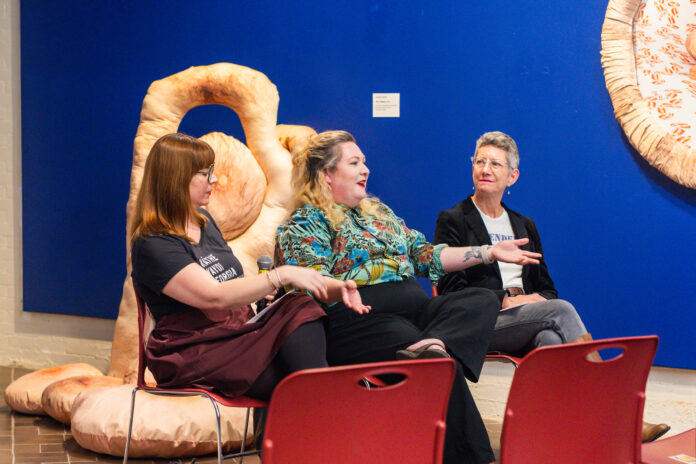In the galleria of Muhlenberg’s Baker Center for the Arts (CA) there has been an exhibit titled “Glut and Guzzle” displayed since the start of the academic year. This exhibit is a series of photographs that illustrate different forms of the body, some accompanied by food. Initial responses and reactions to the exhibit by the student body were those of shock, discomfort and fascination. Ashe Kaye, the artist of this exhibit, came to Muhlenberg on Oct. 16 to discuss their thought process when putting together the exhibit, and the meaning behind the art.
Kaye works as a multidisciplinary artist, as well as a photographer, educator and an object maker who uses 3D technology to explore the interconnectedness of gender norms, sexuality and indulgence. Their work deals with and challenges normative ideas of gender expression and identity, while being reflective of their journey in gender and breaking free of the expectations placed onto them during their upbringing. Kaye grew up in a Mormon household, and this plays a large role in their art currently, as they navigated their life through a Mormon lens, to then rejecting Mormonism entirely. Kaye spoke about how rejecting their Mormon upbringing played a large role in the “Glut and Guzzle” work, stating, “This work was right after I left my Mormon upbringing and I was going through an exploration period. I was exploring things I wasn’t able to experience, and all the things I was repressing. Growing up Mormon…I knew I didn’t want kids. Which was different from everyone I was around, and I struggled with that.”
“The people who are vocal help the people who are less vocal feel more comfortable,”
Ashe Kaye
There was a piece in the exhibit where a female-presenting person is photographed with a stoic and blank expression on their face while cracking an egg in their hand, with a small male-presenting body in the corner. Kaye speaks to this piece and how it is a reflection of the feelings they grappled with while being Mormon saying, “The female-presenting person in this, with the blank expression on their face is kind of representative of being stuck in something so mechanical, and this mounted male-presented flesh overlooking, there’s tension there. And then there’s an implied tension of being a mother and cracking the egg– and the egg can symbolize fertility and motherhood in many cases.”
The exhibit deals largely with photographing different areas of the body, and many of the photos have food immersed in the image as well. There is a photo that is a close-up of someone taking a bite out of a hot dog, with another photo of someone’s face covered with cake, while their eyes are rolled back and their mouth is wide open. When describing how food played an integral part in the photography in this exhibit Kaye said, “As a female-presenting person, most of my life being a bigger person, I have always struggled with food. So I use food as a metaphor a lot in my art. Food, and consumption of food can be used so metaphorically, when expressing indulgence, or in how overconsumption makes us feel. Like, if you eat too many sweets, you feel sick. A lot of the time, I felt that way about my own body. So having that in my work was important to me.”
Kaye and their partner collaborated for many of the pieces in the exhibit, as Kaye stated that certain pieces were to highlight their partner’s exploration of gender identity. Kaye expressed, “I collaborate with my partner. This work came out of both of our gender journeys, and it was so beautiful to come together as artists to express this together, and then accept that.”
“I’m less interested in people being uncomfortable, and more interested in what they’re doing with that discomfort.”
Jessica Ambler
There is a photograph in this exhibit that shows a person unclothed, attempting to sew up a doll. This was a piece Kaye and their partner collaborated on to express what their gender exploration was like, and how it has felt like for them, as Kaye stated, “It’s meant to show an act of sewing yourself back together, after feeling so gross in your own body. There’s a theme of acceptance and love in this.”
The exhibit is meant to showcase Kaye and their partner’s journey into realizing their gender, grappling with their identities in relation to the system of beliefs they grew up with and then their eventual acceptance and love for their identities. Kaye speaks about how important they felt it was to display this work by stating, “It’s important to give a voice and representation to issues regarding gender identity, and give other people struggling a place to see that ‘it’s not just me.’”
“The people who are vocal help the people who are less vocal feel more comfortable,” they continued.
Since the exhibit elicited so much shock from many observers, the idea of putting a content warning ahead of the exhibit was discussed at the talk where Kaye expressed, “I really rejected the idea of a content warning. Putting a content warning on bodies we already police, when there isn’t full nudity, I felt very strongly about not having that. Having a content warning on bodies we already police, trans bodies and female bodies, does not further the conversation. You can like it, you can hate it, but associating content warnings on bodies with police, I felt very strongly about not having that.”
Esther Klinger ‘25 stated “It’s important to showcase art that makes you uncomfortable because it is the artist’s real experience and it is valid. They want to show that and it’s cool that Muhlenberg gave them the opportunity to do so.”
The exhibit was displayed during Orientation Weekend, where the incoming first-year students were able to see it all as soon as they came onto campus. When asked about the reasoning behind this decision, Director of the Martin Art Gallery Jessica Ambler stated, “I want people to show up and see themselves. To see this is a place where they belong. They can express themselves. And that’s especially important for freshmen, they are on their own for the first time and free of parents and guardians, and they can explore themselves more. I’m less interested in people being uncomfortable, and more interested in what they’re doing with that discomfort.”
Anna Hanley ‘25, who was taken aback by the exhibit at first, gave her thoughts on it after hearing Kaye speak about the work saying, “It feels so personal to the artist but yet so many people can see themselves in it as well, and it’s universal that way. It’s there to spark a conversation.”
Shinam ‘25 is a political science and sociology major at Muhlenberg. She is immensely excited to be apart of the Weekly staff! When she isn’t writing, she can be found reading a book or watching a comfort show with her favorite fast food!























